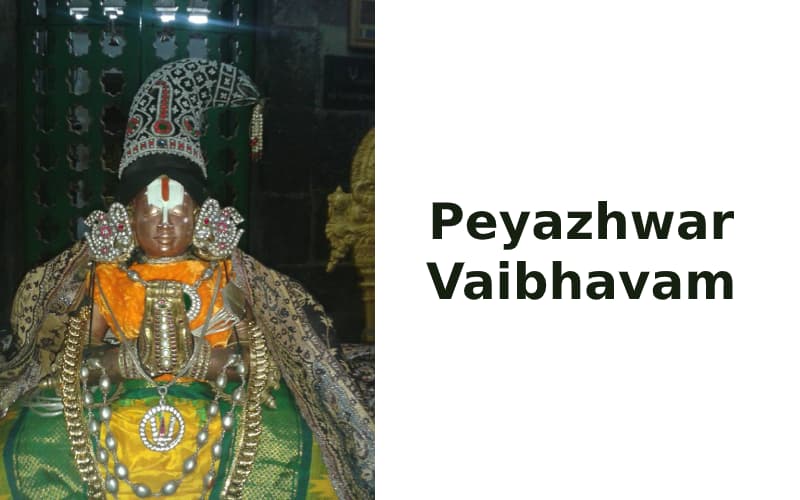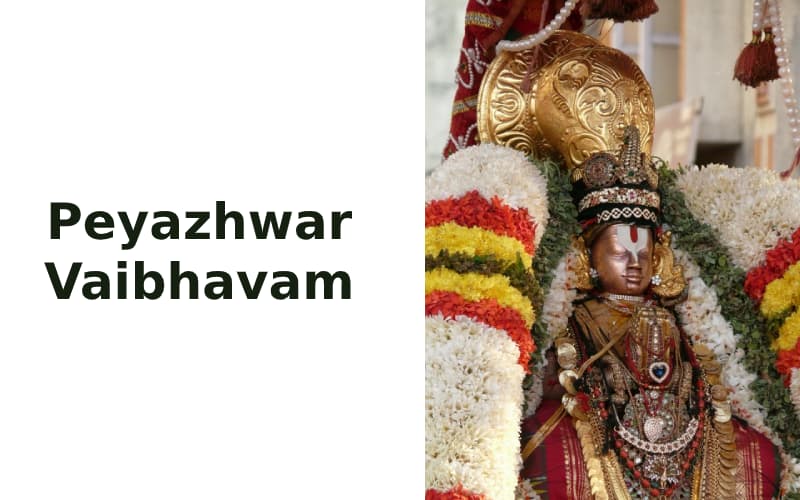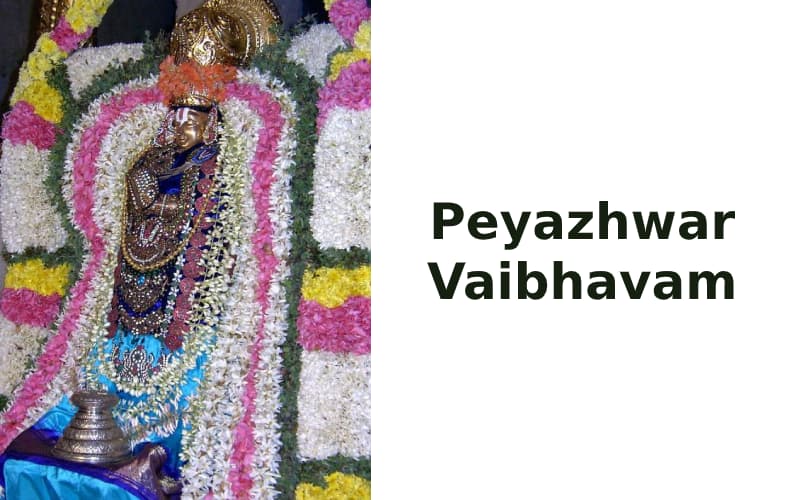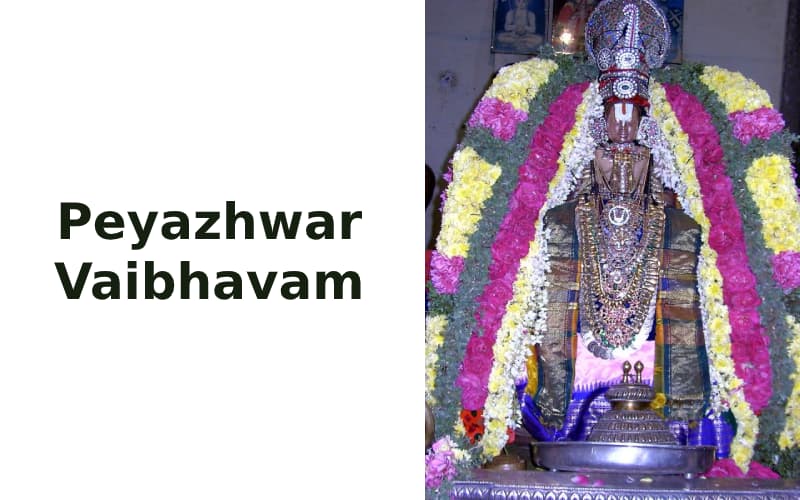
(Note: certain English words are transliterated directly from Tamil. Hence, the formal English rules of using capital letters and italics have been avoided. Usage of capital letters indicate the elongation of sounds in Tamil words. For example: ‘Azhwar’ is spelt as aazhwar indicating letter ‘அ’).
sriman narAyana, the primordial one, incarnated himself in manifold ways to redeem the spirits on this planet. But, he was not satisfied with his mission. Hence, out of his mercy to redeem the spirits, he sent the spirits of his attendants themselves to this planet. Just like getting a wild elephant with the help of a trained elephant. Those endowed spirits had an innate tendency to melt in devotion towards the Lord and words of wisdom sprang from them spontaneously. As they were fully immersed in devotion they came to be known as Azhwars. Azhwars are the devotees of Lord Vishnu from the southern part of India. They propagated Vishnu bhakti in their region. Azhwars are twelve in number. Their verses tinged with devotion are classified as pAsurams and are compiled into a book called ‘nAlAyira divya prabhandam’. The foremost Azhwars among the twelve are poigai Azhwar, bhutath Azhwar and pey Azhwar. In this article, let us discuss the greatness of peyAzhwar.
peyAzhwar, one among the three principal Azhwars, the other two being poigai Azhwar and bhutath Azhwar, was found on the lily flower in the well of Adi kEshava Perumal temple situated in Mylapore. All the three are believed to be born out of divinity (Ayonija). pEyAzhwar is revered as the incarnation of the transcendental sword ‘nandaka’ of Vishnu. He lived in dvApara yuga (the yuga in which krishnAvatharam took place). peyAzhwar served the Lord Adi kEshava Perumal with floral offerings coupled with his verses out of devotion. He is also known as mahathAvayar. As he was disinterested towards worldly activities, people thought he was possessed with apparition, and so they called him ‘Pey’ in Tamil. He was always found in trance. His mind was brimmed with sublime thoughts. The Vaishnavite literature celebrates the three Azhwars together always as ‘mudhalAzhwargal’- The foremost azhwars. One cannot end explaining any one Azhwar among these three without touching the other two.

Hence, it is essential to know about the other two azhwars who were his contemporaries as well. poigai Azhwar, born in a pond as an incarnation of divine conch ‘pAnchajanyam’, near yathokthakAri Perumal temple at Kanchipuram. In Tamil, Poigai means pond. Thus, He is known as Poigai Azhwar since he was born in a pond. bhUtathAzhwar, born in a Liquorice flower as an incarnation of divine mace (koumodaki) near sthalasayana Perumal temple at thirukadalmallai (Mahabalipuram). Though they were born at different places physically, the lord made them to congregate at thirukOvilur, a famous temple dedicated to trivikrama Perumal. Let us know how the trio met each other at thirukOvilur. Once, peyAzhwar had a desire to go on a pilgrimage to other temples of Lord Vishnu. While he visited many temples, he reached thirukOvilur. All the three Azhwars converged at the enclosure.
One night it was raining profusely when poigai Azhwar reached thirukOvilur. Since it was dark and raining, poigai Azhwar decided to rest at a small enclosure which had the capacity to permit a person to recline, two persons to sit and three persons to stand. Such a small enclosure. As poigai Azhwar reclined at the enclosure, bhutath Azhwar arrived at the enclosure seeking shelter. poigai Azhwar shared his space with bhutath Azhwar and they both were sitting now. They were discussing the pastimes of the lord Vishnu during his numerous incarnations and relished in it. At that time, peyAzhwar too came there seeking shelter in the enclosure. This time, the two accommodated the other and now the three Azhwars were standing at the enclosure.
Krishna says in Bhagavad Gita,
“Mat chitta mad gatha prana bhodhayantha parasparam
Kathayanthascha mam nityam tusyanticha ramanthicha” (B.G. 10.9)
Meaning: Krishna explains the qualities of a devotee and their association. The devotees always engage in discussing about the lord and his auspicious activities. The devotees are ever satisfied with this discussion alone and they enjoy listening and speaking on it more and more.

The three Azhwars spent their time on discussing the pastimes of the lord like varAha charitam, nrusimha avatharam, trivikrama charitham and so on.
The Merciful Lord once said to nArada thus,
“nAham vasAmi vaikunte na yogi hrudayE ravou
mad bhakthA yatra gAyanti tatra thistami nArada”
means to say that the Lord neither resides in ‘sri vaikuntam’ nor in the hearts of the yogis but amidst the devotees who sing his praise.
Lord himself came amidst the three Azhwars who were immersed in devotion. The Lord didn’t come alone he came along with his consorts as well. As soon as the Lord arrived there, the three Azhwars felt uneasiness among them as the enclosure didn’t have adequate space to allow someone, the Azhwars were intrigued to see the newcomer. Since it was the dead of the night and heavy downpour, they couldn’t see the newcomer clearly. So, they were in a need of a lamp. They did not have any provisions handy to light a lamp.
poigai Azhwar lit one lamp with a verse in which he utilized the whole world as the lamp, seas and oceans as oil and the sun himself as the light. There started his verses praising the Lord in hundred verses. These verses were compiled as mudhal thiruvanthAdhi.
“வையம் தகளியா வார்கடலே நெய்யாக,
வெய்ய கதிரோன் விளக்காக-செய்ய,
சுடராழி யானடிக்கே சூட்டினேன்சொன் மாலை,
இடராழி நீங்குகவே என்று.”
“vaiyyam thakaliyA vArkadalE neiyAka
veiyya kathirOn vilakkAka- seiyya
sudarAzhi yAnadikkE sootinEn soun mAlai,
IdarAzhi nEinkukavE endru.”

Still, poigai Azhwar’s lamp was not sufficient to see the newcomer clearly. So, bhutathazhwar lit another lamp utilizing universal, Love as lamp, his concentration as fuel, his consciousness as the wick and his wisdom as light. He too gave hundred verses which were compiled as ‘irandAm thiruvanthAdhi’.
“அன்பே தகளியா ஆர்வமே நெய்யாக,
இன்புருகு சிந்தை யிடுதிரியா,- நன்புருகி,
ஞானச் சுடர்விளக் கேற்றினேன் நாரணற்கு,
ஞானத் தமிழ்புரிந்த நான்.”
“anbE thakaliyA Arvame neiyAka,
inburuku sindhai iduthiriyA,- nanburuki,
gnanach sudarvilak kEtrinEn nAranarku,
Now that both the lamps were lit, peyAzhwar could clearly see the chest of the lord which is the seat of mahAlakshmi. peyAzhwar saw mahAlakshmi seated in the chest of the lord and started singing that he had seen the Goddess. He also gave hundred verses compiled as ‘mundrAm thiruvanthAdhi’
“திருக்கண்டேன் பொன்மேனி கண்டேன் திகழும்,
அரக்கன் அணிநிறமும் கண்டேன்,- செருக்கிளரும்,
பொன்னாழி கண்டேன் புரிசங்கம் கைக்கண்டேன்,
என்னாழி வண்ணன்பால் இன்று”
“thirukkandEn ponmEni kandEn thigalum,
arakkan aniniramum kanden - serukkilarum,
ponnAzhi kandEn purisangam kaikkandEn,
The Lord mercifully appeared to the eyes of the Azhwars and they were immensely pleased with the vision of the Lord Vishnu with his consorts. They continued their pilgrimage. thirumazhisai Azhwar, the incarnation of divine discus, joined them on the way. All the four reached mayurApuri. Thirumazhisai Azhwar was initiated spiritually by peyAzhwar and thirumazhisai Azhwar sat in meditation at mayurApuri (the birthplace of peyAzhwar). peyAzhwar visited many temples like thiruvengadam, srirangam, thirukudanthai, thiruvinnagar, thirukoshtiyur and so on. peyAzhwar lived long on this earth and served the Lord with his pAsurams.
In a nutshell, we can get three messages through their pAsurams.
Mudhal Thiruvandhadhi: Atma is subservient to paramAtma. We must serve Him and His devotees with utmost devotion till our last breath.
Irandaam Thiruvandhadhi: sriman nArayanan’s compassion is the only means to Liberation.
Mundraam Thiruvandhadhi: saranAgathi is quite natural and simple so abstain from strenuous austerities. Just like parents take care of children, the super-soul (paramAtma) takes care of spirit soul (jIvAtma).
Glossary:
andhAdhi - form of poetry is that the ending syllable of the previous stanza becomes the starting syllable of the next stanza.
Perumal - General way of referring to Vishnu in Tamil Nadu meaning, ‘purushOthama’ - the Supreme Being.
pAsuram - the hymns of the Azhwars are called as pAsurams
You can contact Naveen Hari @ [email protected], naveencbe.blogspot.com
NEXT ARTICLE

At the southernmost tip of this mesmerising ensemble lies the majestic Great Nicobar Island, boasting an impressive landmass of about 910 square kilom...

Bharath has always been a land traversed by spiritual masters/ Guru since time immemorial. These spiritual masters have always upheld the core princip...

South India contains its fair share of unique pilgrimage centres. These divine places of worship have a prominent Sthala Purana, devoted followers, di...